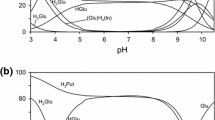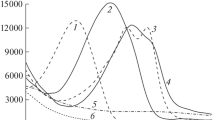Abstract
Reaction of Cu2+ and Zn2+ with highly stable glutathionate gold(I) complexes in aqueous solution (T = 25°C, I = 0.2 M (NaCl)) has been studied, the reaction gives rise to formation of heterobinuclear complexes where glutathionate coordinates to gold(I) via deprotonated thiol group, while copper(II) or zinc(II) are bound to the glycinate fragments (GF) of glutathione. It has been shown that copper(II) in solution binds to two GF related to different glutathionate ions, while zinc(II) binds to one GF. In the pH region 6–9, for (AuGS)m\({\text{H}}_{m}^{{m-}}\)polymeric 1 : 1 complex, the most probable forms of heterobinuclear complexes are (AuGS)mCun\({\text{H}}_{{m\,\, - \,\,2n}}^{{m-}}\) and (AuGS)m(ZnOH)n\({\text{H}}_{{m\,\, - \,\,n}}^{{m-}}\) with variable number of M2+, where GS3– is deprotonated glutathione residue. The solutions remain homogeneous until \(C_{{\text{M}}}^{{2 + }}\) : CGS < 0.5. Formation of solid phases of complexes is observed at \(C_{{\text{M}}}^{{2 + }}\) : CGS > 0.5



Similar content being viewed by others
REFERENCES
E. V. Makotchenko, I. A. Baidina, and I. V. Korol’kov, Russ. J. Inorg. Chem. 64, 41 (2019). https://doi.org/10.1134/S0036023619010157
N. V. Cherkashina, A. V. Churakov, I. A. Yakushev, et al., Russ. J. Coord. Chem. 45, 253 (2019). https://doi.org/10.1134/S107032841904002X
G. Y. Zhigulin, G. S. Zabrodina, M. A. Katkova, and S. Y. Ketkov, Russ. J. Coord. Chem. 45, 356 (2019). https://doi.org/10.1134/S107032841905004X
M. Wenzel, E. Bigaeva, P. Richard, et al., J. Inorg. Biochem. 141, 10 (2014). https://doi.org/10.1016/j.jinorgbio.2014.07.011
M. Wenzel, A. de Almeida, E. Bigaeva, et al., Inorg. Chem. 55, 2544 (2016). https://doi.org/10.1021/acs.inorgchem.5b02910
A. Majzik, L. Fulop, E. Csapó, et al., Colloids Surf. 81, 235 (2010). https://doi.org/10.1016/j.colsurfb.2010.07.011
M. Bieri and T. Burgi, Phys. Chem. Chem. Phys. 8, 513 (2006). https://doi.org/10.1039/b511146c
H. Ao, H. Feng, K. Li, et al., Sens. Actuators, B: Chem. 272, 1 (2018). https://doi.org/10.1016/j.snb.2018.05.151
B. Söptei, J. Mihály, I. Cs. Szigyártó, et al., Colloids Surf. A 470, 8 (2015). https://doi.org/10.1016/j.colsurfa.2015.01.048
Z. Luo, X. Yuan, Y. Yu, et al., J. Am. Chem. Soc. 134, 16662 (2012). https://doi.org/10.1021/ja306199p
D. H. Brown and W. E. Smith, J. Chem. Soc., Dalton Trans. 9, 217 (1980).
C. F. Shaw III, Chem. Rev. 99, 2589 (1999). https://doi.org/10.1021/cr980431o
F. Mohr, Gold Chemistry (Wiley-VCH Verlag GmbH & Co, Weinheim, 2009).
I. V. Mironov and V. Yu. Kharlamova, J. Sol. Chem. 47, 511 (2018). https://doi.org/10.1007/s10953-018-0735-y
C. H. Gammons, Y. Yunmei, and A. E. Wiliams-Jones, Geochim. Cosmochim. Acta 61, 1971 (1997). https://doi.org/10.1016/S0016-7037(97)00060-4
I. V. Mironov and V. Yu. Kharlamova, Russ. J. Inorg. Chem. 61, 123 (2016). https://doi.org/10.1134/S0036023616010174
H. S. Harned and B. B. Owen, The Physical Chemistry of Electrolytic Solutions (Reinhold, New York, 1950).
I. V. Mironov and V. Yu. Kharlamova, J. Solution Chem. 49, 583 (2020). https://doi.org/10.1007/s10953-020-00994-0
P. Nagy and C. C. Winterbourn, Adv. Mol. Toxicol. 4, 189 (2010). https://doi.org/10.1016/S1872-0854(10)04006-3
T. Kiss, I. Sovago, and A. Gergely, Pure Appl. Chem. 63, 597 (1991). https://doi.org/10.1351/pac199163040597
T. R. Usacheva, L. Pham Thi, K. I. Kuzmina, and V. A. Sharnin, J. Therm. Anal. Calorim. 130, 471 (2017). https://doi.org/10.1007/s10973-017-6207-6
H. Kozlowski, W. Bal, M. Dyba, and T. Kowalik-Jankowska, Coord. Chem. Rev. 184, 319 (1999). https://doi.org/10.1016/S0010-8545(98)00261-6
K. Miyoshi, Y. Sugiura, K. Ishizu, et al., J. Am. Chem. Soc. 102, 6131 (1980). https://doi.org/10.1021/ja00539a027
I. Sóvágó, C. Kállay, and K. Várnagy, Coord. Chem. Rev. 256, 2225 (2012). https://doi.org/10.1016/j.ccr.2012.02.026
J. Z. Pedersen, C. Steinkuhler, U. Weser, and G. Rotilio, Biometals 9, 3 (1996). https://doi.org/10.1007/BF00188083
I. Sóvágó and O. Katalin, Dalton Trans. 3841 (2006). https://doi.org/10.1039/b607515k
M. Farrag and R. A. Mohamed, J. Photochem. Photobiol., A: Chem. 330, 117 (2016). https://doi.org/10.1016/j.jphotochem.2016.07.027
J. Berger, J. Raman Spectrosc. 5, 103 (1976). https://doi.org/10.1002/jrs.1250050202
A. W. Herlinger, S. L. Wenhold, and T. Veach Long II, J. Am. Chem. Soc. 92, 6474 (1970). https://doi.org/10.1021/ja00725a015
Funding
This work was supported by the Ministry Science and Higher Education of the Russian Federation, project no. 121031700315-2.
Author information
Authors and Affiliations
Corresponding author
Ethics declarations
The authors declare no conflicts of interest.
Additional information
Translated by I. Kudryavtsev
Supplementary Information
Rights and permissions
About this article
Cite this article
Mironov, I.V., Kharlamova, V.Y. The Cu2+ and Zn2+ Heterobinuclear Complexes Based on Gold(I) Glutathionate Complexes in Aqueous Solution. Russ. J. Inorg. Chem. 67, 231–236 (2022). https://doi.org/10.1134/S0036023622020097
Received:
Revised:
Accepted:
Published:
Issue Date:
DOI: https://doi.org/10.1134/S0036023622020097




